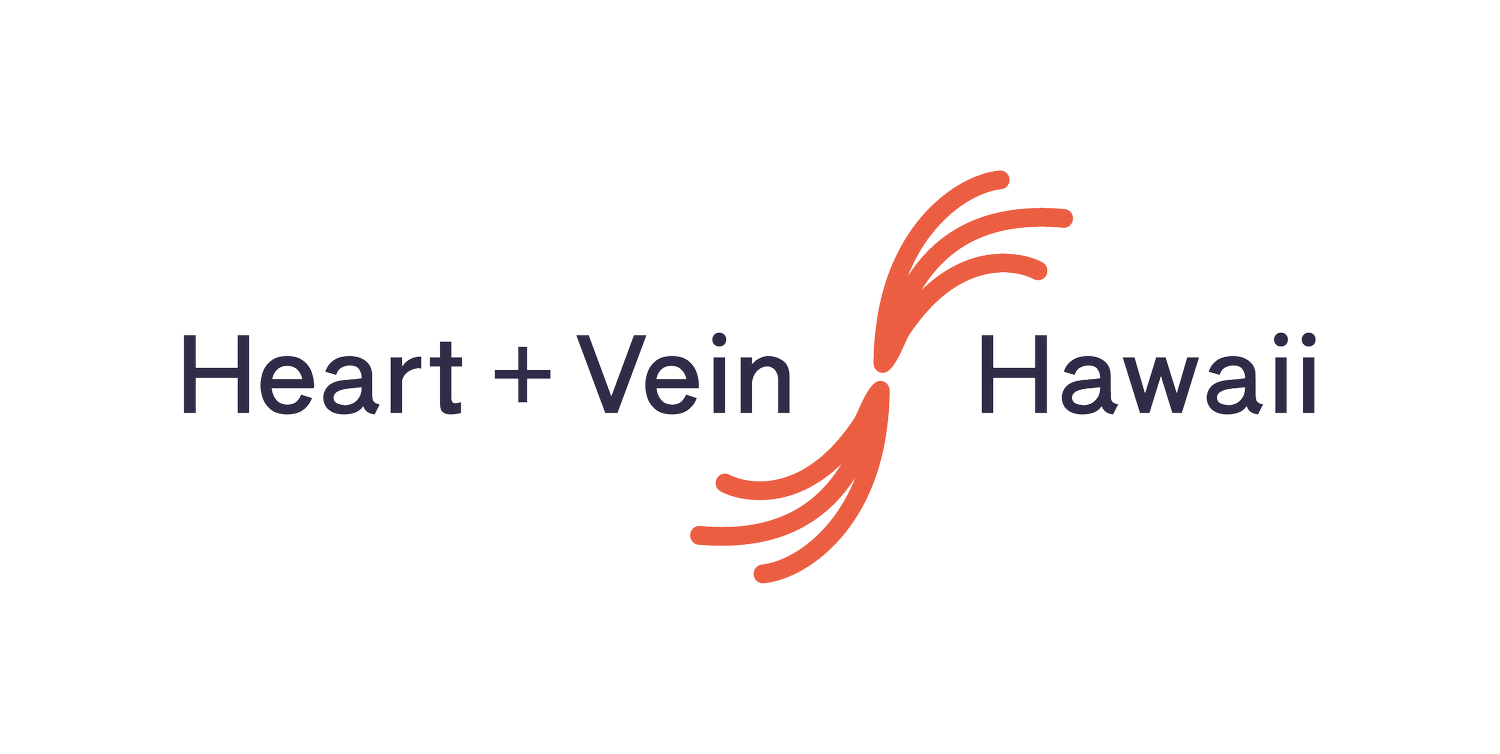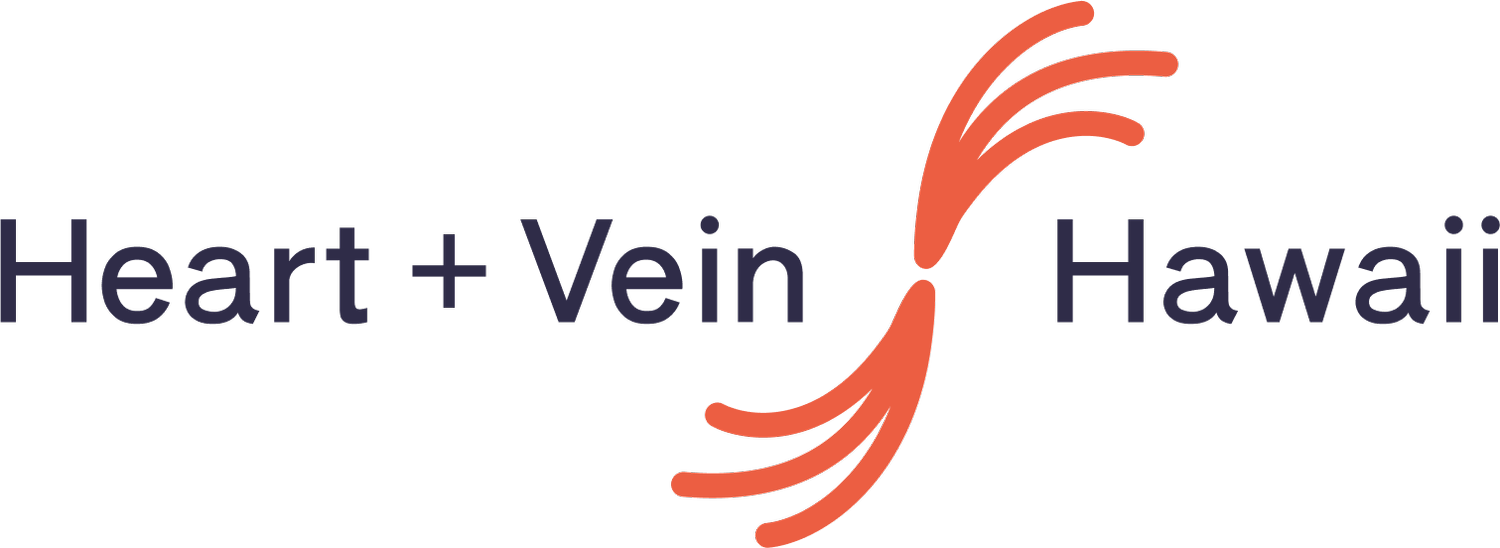
Heart Conditions
Being heart smart starts with knowing your risk factors and taking preventative measures. At Heart and Vein Hawaii, our team has more than 30 years of experience in cardiology to help you guide you through your heart health journey.
Atrial Fibrillation
Atrial fibrillation is usually diagnosed with an electrocardiogram (EKG or ECG). Other tests may include blood tests looking for thyroid or liver problems, an echocardiogram or a stress test.
Atrial fibrillation can be controlled by reducing caffeine intake, controlling blood pressure, limiting alcohol consumption, treating an overactive thyroid, and getting regular exercise.
While atrial fibrillation may present itself without symptoms, patients with symptoms might experience:
• Irregular heartbeats
• Chest tightness
• Lightheadedness
• Dizziness
• Trouble breathing
Atrial fibrillation is usually diagnosed with an electrocardiogram (EKG or ECG). Other tests may include some blood tests looking for thyroid or liver problems, an echocardiogram, an ultrasound picture of the heart looking at the heart’s pumping function and checking the heart valves out. Also, a stress test may be performed to check the heart’s circulation.
Treatment may include one or more of the following:
Medications to control the heart rate or speed of the heart
Blood thinners to prevent blood clots from forming in the heart and to prevent strokes
Cardioversion an electric shock to the heart to fix or restore a normal heartbeat
Atrial fibrillation ablation using either radiofrequency or cold to destroy the abnormal tissue in the heart that is causing the atrial fibrillation
Pacemakers
Surgery to create scar tissues to block the flow of the electrical signals (Maze Procedure)
Many people are able to live a normal life with atrial fibrillation, although it is very important for them to take their medications to control the heart rate and to prevent strokes.
Blood Pressure
WHY IT’S IMPORTANT TO MANAGE YOUR BLOOD PRESSURE.
Hypertension, or high blood pressure, is often referred to as the ‘silent killer,’ as it usually doesn’t cause any symptoms until a catastrophe happens such as a heart attack. The goal of treating your blood pressure is to lower it, decreasing the chances of a heart attack, stroke, or kidney failure in the future.
HEALTHY BLOOD PRESSURE
An ideal blood pressure is consistently below 140/90. If you have had a heart attack or are diabetic, it is best to have a blood pressure below 130/80. The optimal blood pressure for everyone, associated with the lowest for incidents is 120/80.
We recommend checking your blood pressure three to four times a day over a two week period once you start treatment, and keeping a log of your readings to discuss with the doctor at your next visit. It is a good idea to periodically check your blood pressure following treatment as well.
Congestive Heart Failure
Heart failure, sometimes known as congestive heart failure, occurs when your heart muscle doesn’t pump blood as well as it should. Certain conditions, such as narrowed arteries in your heart (coronary artery disease) or high blood pressure, gradually leave your heart too weak or stiff to fill and pump efficiently.
Not all conditions that lead to heart failure can be reversed, but treatments can improve the signs and symptoms of heart failure and help you live longer. Lifestyle changes (such as exercising, reducing salt intake, managing stress and losing weight) can improve your quality of life.
One way to prevent heart failure is to control conditions that cause heart failure, such as coronary artery disease, high blood pressure, diabetes or obesity.
HEART FAILURE SIGNS AND SYMPTOMS MAY INCLUDE:
Shortness of breath (dyspnea) when you exert yourself or when you lie down
Fatigue and weakness
Swelling (edema) in your legs, ankles and feet
Rapid or irregular heartbeat
Reduced ability to exercise
Persistent cough or wheezing with white or pink blood-tinged phlegm
Increased need to urinate at night
Swelling of your abdomen (ascites)
Sudden weight gain from fluid retention
Lack of appetite and nausea
Difficulty concentrating or decreased alertness
Sudden, severe shortness of breath and coughing up pink, foamy mucus
Chest pain
WHEN TO SEE A DOCTOR
See your doctor if you think you might be experiencing signs or symptoms of heart failure.
SEEK EMERGENCY TREATMENT IF YOU EXPRIENCE ANY OF THE FOLLOWING:
Chest pain
Fainting or severe weakness
Rapid or irregular heartbeat associated with shortness of breath, chest pain or fainting
Sudden, severe shortness of breath and coughing up pink, foamy mucus
Although these signs and symptoms may be due to heart failure, there are many other possible causes, including other life-threatening heart and lung conditions. Don’t try to diagnose yourself. Call 911 or your local emergency number for immediate help. Emergency room health care providers will try to stabilize your condition and determine if your symptoms are due to heart failure or something else.
If you have a diagnosis of heart failure and if any of the symptoms suddenly become worse or you develop a new sign or symptom, it may mean that existing heart failure is getting worse or not responding to treatment. Contact your doctor promptly.
Coronary Artery Disease
Coronary artery disease is one of the leading causes of heart attacks. When you have CAD, the arteries that supply blood to the heart harden and narrow, making it hard for blood to reach the heart muscle. This raises your risk for heart attack and stroke because as the heart fails to pump blood into the rest of the body, your tissues and organs lose their ability to gain oxygen and can begin to shut down.
COMMON SYMPTOMS OF CAD INCLUDE:
Chest pain
Pain in the back, shoulders, jaw, or neck
Indigestion
RISK FACTORS INCLUDE:
Age
Gender
Heredity
Diabetes
Lifestyle (smoking, diet, physical activity, and stress)
Maintaining a healthy diet and lifestyle is the best way to keep the heart healthy and the rest of the body supplied with blood (carrying oxygen). At Heart and Vein Hawaii, we provide a full set of diagnostic tests to look for early signs of coronary artery disease. While coronary artery disease cannot be cured, with the right preventative measures in place, you can live a healthy and full life.
Diet
YOU ARE WHAT YOU EAT!
The optimal diet to prevent heart attacks is a plant-based, whole food diet rich in fruits and vegetables (at least ten servings a day), low glycemic and high in fiber.
FOR A HEART- HEALTHY DIET, AVOID:
White rice and pasta
Cakes, cookies and candies
Fried foods and potato chips
Donuts
Sodas and fruit juice
Energy and sports drinks
Animal protein
Dairy products
Oils
If giving up animal protein sound challenging, try limiting intake to the following:
Red meat once a month
Poultry and fish once a week
Cheese once a week
Olive oil sparingly
Vitamin supplements and fish oil capsules are not recommended. Prescription capsules are available if you wish to take fish oils, which are better than over the counter options. Following a healthy diet, using the tips above, will get all of your essential nutrients as whole food. In rare instances of a deficiency, vitamin B12 and vitamin D supplementation are recommended.
Heart Attack
Heart attacks occur when there is a lack of blood flow to the heart. This can lead to heart muscle damage and/or death due to a lack of oxygen transported in the blood.
The damaged muscle tissue may be replaced with scar tissue, which can have permanent effects. Heart attacks are most commonly caused by Coronary artery disease (CAD) and are linked to other conditions such as Congestive heart failure (CHF).
Symptoms of a heart attack include:
• Chest pain or discomfort
• Upper body pain in the arms, back, neck or jaw
• Stomach pain and nausea
• Shortness of breath
• Fainting or lightheadedness
• Cold sweats
Peripheral Artery Disease
WHAT IS PERIPHERAL ARTERY DISEASE?
Peripheral artery disease (PAD) is a condition caused by plaque build-up in leg arteries that create a blockage in the blood vessels.
The symptoms of PAD include:
Pain in the back of the lower leg, worsened with exercise and relieved by rest.
Pain in the feet, thighs and buttocks
Difficulty walking up stairs
Erectile problems in men
Decreased female arousal
The basic test for PAD is an ankle-brachial index or ABI where the blood pressure in the arms is compared to the blood pressure in the legs. Another common test performed is an ultrasound of the leg blood vessels.
POSSIBLE TREATMENTS INCLUDE:
Quitting smoking
Controlling diabetes, high blood pressure and high cholesterol
Angioplasty and stenting
Taking medications to control pain and improve circulation
Exercising
Surgery can be done where a bypass around the blockage is made either by using other blood vessels in the body or a manmade graft is inserted
WHO IS AT HIGHER RISK FOR PAD?
People with diabetes
People who smoke
People who have a history of high blood pressure
People with high cholesterol
Strokes
Common medical conditions such as high blood pressure, high cholesterol and heart disease can increase your risk for stroke. Strokes occur when a clogged or burst blood vessel cuts off circulation to the brain, causing brain cells to die. The result can lead to paralysis, speech problems and death, but the extent of damage depends on how many cells have died and how quickly the stroke is treated.
IF YOU THINK YOU MAY BE HAVING A STROKE, REMEMBER F.A.S.T:
F – Face: is the face uneven or does it droop on one side?
A – Arm: is there a weakness or numbness in an arm? Does one arm drift down when held out?
S – Speech: Is the person having trouble speaking?
T – Time: If there are signs of a stroke seek help immediately. The sooner the treatment the better the chances of recovery.
POSSIBLE TREATMENTS MAY INVOLVE:
Medication to break up blood clots
Medication to prevent blood clots
Discontinuation of blood thinning medications, for strokes that involve bleeding in the brain
Surgery
Carotid Endarterectomy, or clearing blockages in the neck arteries
A Transient Ischemic Attack (TIA) is a stroke where no permanent brain damage occurs. In this case, occurs a blood vessel in the brain re-opens after being blocked for only a short time. A TIA is often a warning that a larger stroke may occur.
STOKE PREVENTION TIPS:
Quit smoking
Exercise regularly
Maintain healthy weight
Eat a healthy diet low in fat and rich in fruits and vegetables
Limit salt intake
Limit alcohol intake
Maintain healthy blood pressure control
Maintain healthy diabetic control
Add cholesterol medications, usually a statin
Add a blood thinner such as aspirin

